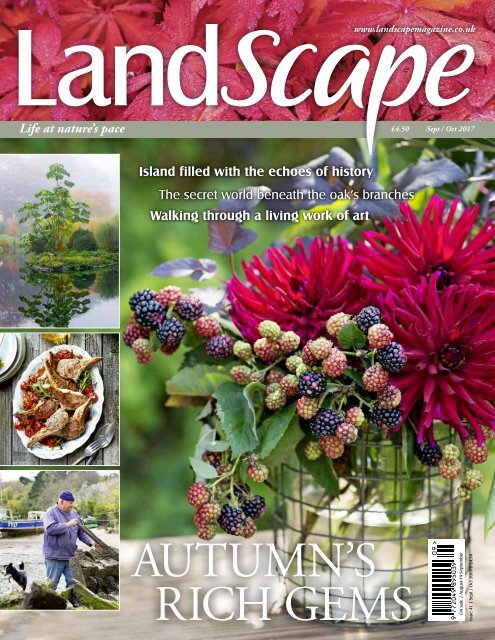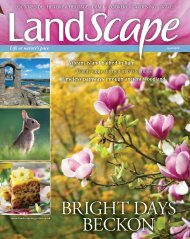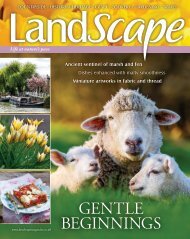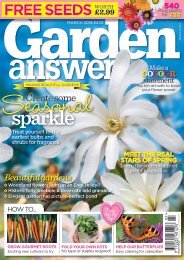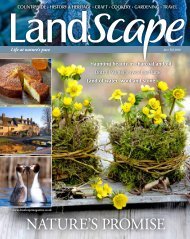Create successful ePaper yourself
Turn your PDF publications into a flip-book with our unique Google optimized e-Paper software.
www.landscapemagazine.co.uk<br />
Life at nature’s pace<br />
£4.50 Sept / Oct 2017<br />
Island filled with the echoes <strong>of</strong> history<br />
The secret world beneath the oak’s branches<br />
Walking through a living work <strong>of</strong> art<br />
1<br />
AUTUMN’S<br />
RICH GEMS<br />
On sale 2 August-19 September<br />
Issue 41 | Sept / Oct 2017 | £4.50
Contents<br />
September / October 2017<br />
36<br />
84<br />
92<br />
In the garden<br />
In the kitchen<br />
Craft<br />
10 Trees aflame with autumn colour<br />
18 Hebes put on a spectacular show<br />
30 The garden in September and<br />
October<br />
36 Vistas within a granary garden<br />
44 Mutton’s deeper flavour<br />
48 The perfect custard tart<br />
52 A nutty taste to savour<br />
58 Regional & Seasonal:<br />
Roaches Tea Rooms<br />
24 Dahlias make an impact<br />
66 Friends from woodland finds<br />
76 New life for old trinkets<br />
100 A stout knitted owl<br />
4
100<br />
110<br />
52 24<br />
Country matters<br />
78<br />
History and heritage<br />
Regulars<br />
60 Out with the mushroom hunter<br />
68 Putting flowers centre stage<br />
78 Replicating the grace <strong>of</strong> seabirds<br />
92 Life under the mighty oak<br />
84 A landscape in miniature<br />
102 Walk through living masterpieces<br />
110 Island where history abounds<br />
6 Readers’ letters<br />
8 Our <strong>LandScape</strong><br />
34 In the garden<br />
50 Subscription <strong>of</strong>fer<br />
56 In the kitchen<br />
74 In the home<br />
120 UK events<br />
5
10
On the left <strong>of</strong> the water, the gold<br />
and red autumn leaves <strong>of</strong> Nyssa<br />
sylvatica glow. Opposite, on the<br />
right, is Nyssa sinensis. Behind<br />
stands a 400-year-old<br />
cedar <strong>of</strong> Lebanon.<br />
SETTING<br />
AUTUMN<br />
ABLAZE<br />
An East Anglian garden puts on<br />
a spectacular show as it comes<br />
alive with a riot <strong>of</strong> rich colour<br />
TUCKED AWAY DOWN narrow lanes in the<br />
undulating farmland <strong>of</strong> the Essex Suffolk border, a<br />
spectacular autumn display can be seen. Sheltered<br />
from the north wind by a 20 acre nature reserve <strong>of</strong><br />
native trees and shrubs, three tree species, acers, nyssas and<br />
liquidambars, are competing to see which can display the<br />
richest hues in their eight acre garden.<br />
From October through to December, they create a<br />
canvas splashed with scarlet, cerise and deep reds,<br />
punctuated by faded greens and old golds.<br />
Screened from the River Stour by muted amber tones <strong>of</strong><br />
birch trees and a silvery mist <strong>of</strong> willows, the acers are<br />
aglow. The site is home to approximately 50 <strong>of</strong> these<br />
slow-growing, small deciduous trees, with their graceful<br />
habit and beautiful foliage. The predominantly wine-dark<br />
Acer palmatum ‘Osakazuki’ spreads graceful branches to<br />
the ground, with leaves <strong>of</strong> ruby, dark salmon-pink and<br />
flame. Near it, A. japonicum ‘Laciniatum’ bears filigree<br />
foliage <strong>of</strong> raspberry-s<strong>of</strong>t pinks and cream, with touches <strong>of</strong> ›<br />
The red-fringed leaves <strong>of</strong> Acer japonicum ‘Laciniatum’,<br />
known as the downy Japanese maple from the white<br />
hairs on young leaves (far left).<br />
The ground below Acer cappadocicum ‘Aureum’ is<br />
covered with its five-lobed golden leaves (centre left).<br />
The scarlet autumn leaves <strong>of</strong> Acer palmatum<br />
‘Osakazuki’ (left).<br />
11
A glorious mix <strong>of</strong> blooms in all the<br />
colours <strong>of</strong> the autumn spectrum<br />
are informally arranged in a rustic<br />
enamel container (main picture).<br />
A starburst <strong>of</strong> mellow golds in a single<br />
dahlia flowerhead is displayed to full<br />
effect by simply placing it on a leafpatterned<br />
dish, with a sprinkling <strong>of</strong><br />
spiked petals around (opposite page).
OPULENT BEAUTY<br />
With its fulsome blooms and palette <strong>of</strong> warm hues, the dahlia takes<br />
a starring role in a variety <strong>of</strong> autumnal arrangements<br />
25
DEEP IN FLAVOUR<br />
More gamey than lamb, mutton dishes are strong and juicy<br />
Mutton chops<br />
in tomato and<br />
rosemary sauce<br />
Serves 4<br />
8 x 100g mutton chops, at room<br />
temperature<br />
200g on-the-vine tomatoes<br />
3 sprigs fresh rosemary,<br />
plus extra for garnish<br />
2 garlic cloves<br />
1 red onion, peeled and quartered<br />
2 tbsp olive oil<br />
juice <strong>of</strong> ½ lemon<br />
1 tsp honey<br />
1 tbsp tomato puree<br />
150ml white wine<br />
sea salt and white pepper<br />
Preheat the oven to 190°C/gas mark 5.<br />
Place the garlic, tomatoes, onion and leaves<br />
<strong>of</strong> two <strong>of</strong> the rosemary sprigs in a roasting<br />
tray. Drizzle with the oil and season with salt<br />
and pepper. Roast for 25 mins, then transfer<br />
the contents <strong>of</strong> the tray to a saucepan,<br />
squeezing the cooked garlic out <strong>of</strong> its skin<br />
and into the pan. Add the lemon juice,<br />
remaining rosemary sprig, honey, tomato<br />
puree and wine. Bring to the boil and<br />
simmer for 10 mins. Remove the sprig<br />
<strong>of</strong> rosemary.<br />
In the meantime, place the chops in the<br />
roasting tray and season with pepper. Roast<br />
for 18 mins for medium rare and 30 mins<br />
for well done, turning over halfway through.<br />
Allow to rest for 2 mins. Serve with the<br />
tomato and rosemary sauce and extra<br />
rosemary for garnish.
Mutton, carrot and<br />
cumin casserole<br />
Serves 4<br />
500g chopped mutton steak<br />
or leg<br />
300g carrots, trimmed and<br />
chopped<br />
1 tbsp crushed cumin seeds<br />
2 tbsp cornflour<br />
1 tbsp butter<br />
1 tbsp olive oil<br />
8 shallots, peeled<br />
200g green lentils<br />
150ml white wine<br />
500ml vegetable stock<br />
1 tsp honey<br />
sea salt and black pepper<br />
Preheat the oven to 160°C/gas<br />
mark 3. Place the mutton in a<br />
large bowl and sprinkle the<br />
cornflour over, then season with<br />
salt and pepper. Stir until all the<br />
mutton is covered with the<br />
cornflour. Add the butter to a large<br />
ovenpro<strong>of</strong> casserole dish and melt<br />
until liquid. Fry the mutton in the<br />
melted butter for 5-7 mins, stirring<br />
regularly, until brown and sealed.<br />
Remove with a slotted spoon and<br />
set aside.<br />
In the same casserole dish,<br />
add the oil and fry the whole<br />
shallots and cumin seeds for 5-6<br />
mins until browned. Add the<br />
carrots, lentils and white wine and<br />
cook for 5 mins until the wine has<br />
evaporated. Add the stock and<br />
honey and bring to the boil. Mix in<br />
the mutton and cook, covered<br />
with a lid, in the oven for 2 hrs<br />
until thick and glossy.<br />
Mutton roll<br />
Serves 6<br />
2 pieces (500g) neck fillets, at<br />
room temperature<br />
250g strong white flour<br />
150g chilled unsalted butter,<br />
cubed<br />
50g chilled lard, cubed<br />
1 tbsp olive oil<br />
1 egg<br />
sea salt and black pepper<br />
Place the flour in a large mixing bowl, add the<br />
butter cubes and lard, and stir. Mix in 140ml <strong>of</strong><br />
ice-cold water and a pinch <strong>of</strong> salt and pepper.<br />
Bring together into a ball with the hands,<br />
kneading slightly if necessary. Dust a clean<br />
work surface and a rolling pin with flour and roll<br />
the pastry out into a long rectangle. Fold one<br />
end over to halfway down the rectangle, then<br />
fold the bottom up. Turn it 45 degrees, then roll<br />
into a rectangle again. Repeat three more times.<br />
Wrap in cling film and leave to chill for 1 hr.<br />
Season the mutton neck pieces with salt and<br />
pepper, then add the olive oil to a frying pan<br />
and heat until sizzling. Seal the meat, moving<br />
both pieces from side to side, for 15 mins for<br />
rare and 30 mins for medium. Wrap in tin foil<br />
and allow to cool.<br />
Line an oven tray with baking paper. Divide<br />
the pastry into two blocks, then roll out one<br />
piece on a work surface dusted with flour to<br />
approximately 29cm x 14cm. Roll the other<br />
piece to 2cm larger than the first.<br />
Lay the smaller piece on the prepared tray,<br />
then top with the neck fillets, one after another,<br />
down the middle. Beat the egg in a small dish<br />
with a fork, then brush the borders <strong>of</strong> the pastry<br />
rim with egg wash. Cover the top with the other<br />
piece <strong>of</strong> pastry. Trim the sides, leaving a 1cm<br />
border. Allow to chill for 30 mins.<br />
Preheat the oven to 200°C/gas mark 6.<br />
Score the top <strong>of</strong> the pastry with criss-cross<br />
lines, then brush the top with egg wash. Bake<br />
for 20-25 mins until golden and puffed up.<br />
Serve immediately.<br />
45
The tough stems <strong>of</strong> amethyst deceivers, Laccaria<br />
amethystina, can be bent and their caps wavy edged.<br />
THE WILD<br />
MUSHROOM<br />
HUNTER<br />
Wayne Thomas uses his expert eye<br />
to forage for edible fungi in the<br />
woodlands <strong>of</strong> the Wye Valley<br />
THE PALE AUTUMN sun casts its dappled<br />
shadows across the leaf-covered floor <strong>of</strong> a Welsh<br />
wood. Suddenly, the stillness is broken by a<br />
rushed movement, the rustle <strong>of</strong> leaf matter, the<br />
crackle <strong>of</strong> snapping branches and a flash <strong>of</strong> saddle<br />
brown. With a Y-shaped stick in one hand, a wicker<br />
basket in the other, mushroom forager Wayne Thomas<br />
has spotted a suitable specimen.<br />
The forest floor <strong>of</strong> this mixed woodland in the<br />
Wye Valley Area <strong>of</strong> Outstanding Natural Beauty,<br />
Monmouthshire, is still damp from recent rains.<br />
Conditions are perfect for gathering edible fungi.<br />
“Fungi are everywhere,” says Wayne, sweeping his<br />
stick in an indicative arc around him. “Take a cubic<br />
metre <strong>of</strong> woodland soil and there could more than 300<br />
different types. Some are microscopic. It’s only when<br />
they fruit and form mushrooms that we can see them.”<br />
He kneels and points among the decaying leaves at<br />
his feet. There, wiggling skyward in golden yellow and<br />
orange clusters, are the unmistakable gilled caps <strong>of</strong><br />
peppery-tasting winter chanterelles. “Mushroom<br />
hunting is about getting your eye in. When you know<br />
what you’re looking for, it’s like entering a whole new<br />
magical world,” he says. Carefully, he picks a handful<br />
<strong>of</strong> the fungi and places them in his basket. The open<br />
weave allows his finds to air and spread their spores as<br />
he continues along his way.<br />
Wayne points to the leaf litter no more than a few<br />
feet away. “Those are amethyst deceivers,” he says,<br />
referring to a delicate set with fluted caps and irregular<br />
gills. “At their prime, they’re vivid purple, but over<br />
time they lose their colour and turn creamy. They’re<br />
edible, but fibre rich, so not one to over-indulge in.” ›<br />
Wayne’s basket soon starts to fill with creamy-coloured<br />
finds from the forest floor.<br />
“The Mushroom is the Elf <strong>of</strong> Plants --<br />
At Evening, it is not --<br />
At Morning, in a Truffled Hut<br />
It stop upon a Spot”<br />
Emily Dickinson, ‘The Mushroom is the Elf <strong>of</strong> Plants’<br />
61
In the home<br />
Seasonal decorative touches to bring the outdoors in<br />
TIME FOR<br />
A TIDY-UP<br />
As the days start to become<br />
shorter, this is a good time to find<br />
simple ways to tidy up the home.<br />
Leftover balls <strong>of</strong> wool, buttons,<br />
ribbons and cotton reels <strong>of</strong>ten get<br />
jumbled up in boxes. Two old fruit<br />
crates are placed on their side on<br />
top <strong>of</strong> each other to create open<br />
storage for haberdashery and<br />
wool. The yarn is easy to see and<br />
access, ready for any projects<br />
designed to use up remnants.<br />
Smaller pieces can be kept in<br />
glass jars or old biscuit tins.<br />
TARTAN COMFORT<br />
AUTUMN ON<br />
A STRING<br />
At this time <strong>of</strong> year, trees are starting to take on their autumnal<br />
hues as their leaves turn red and gold. Each leaf is burnished in<br />
warm shades, creating a beautiful work <strong>of</strong> art in its own right.<br />
To enjoy these lovely colours at home, a selection <strong>of</strong> leaves and<br />
horse chestnut conkers can be collected, to use for decorations.<br />
Leaves that have not begun to curl and have no tears or<br />
insect damage should be chosen from ones that have fallen to<br />
the ground. Holes are drilled or punched through the conker,<br />
and made in the tops <strong>of</strong> the leaves. Lengths <strong>of</strong> garden twine are<br />
threaded through the leaves, and a conker attached to the end.<br />
The twine is then looped round rolled napkins, to create a<br />
seasonal display for an autumnal meal out <strong>of</strong> doors.<br />
Florence Anne Footstools was started in memory <strong>of</strong> owner Tracey<br />
Bigrigg’s mother, who was called Florence Anne. She was an<br />
interior designer, who especially loved designing footstools. One<br />
day, Tracey decided to start designing the beautiful tartan-covered<br />
footstools herself. All are handmade in her Cumbrian workshop,<br />
using only pure British wool from weavers such as Abraham Moon,<br />
Balmoral and Ross Tweed. The legs are handmade from hardwood.<br />
Tracey ensures the best foam is used that will not sag with use.<br />
60 x 40cm footstool £280,<br />
www.florenceannefootstools.co.uk<br />
74
STARS<br />
OF THE<br />
DAYTIME<br />
Michaelmas daisies take their first name from the<br />
festival <strong>of</strong> St Michael the Archangel, or Michaelmas,<br />
on 29 September. The second part <strong>of</strong> the name,<br />
daisy, comes from ‘day’s eye’. This refers to the<br />
fact that they close their petals up at night and only<br />
open fully during the day. These star-shaped flowers,<br />
with their purple, white or pink petals and colourful<br />
centres, provide cheerful colour through autumn into<br />
the early winter.<br />
To gardeners, they are asters, from astrum,<br />
the Latin for star. First reaching Britain from their<br />
native North America in the 17th century, they have<br />
become firm favourites as border plants. Today, there<br />
are dozens <strong>of</strong> varieties, both single and double, in a<br />
range <strong>of</strong> heights, from 12in (30cm) to 70in (1.8m).<br />
Picking a selection from the garden and placing<br />
each stem in an old bottle or jar creates a seasonal<br />
display that is both delicate and decorative.<br />
CAUGHT IN THREAD<br />
Katrina Witten takes her inspiration for her embroidery kits from the colours<br />
and textures in the Derbyshire countryside. She has embroidered since she<br />
was a child, encouraged by her late mother, an embroidery artist in her own<br />
right. Every Rowandean kit comes with clearly printed designs, threads,<br />
needles and detailed instructions. This kit, from the Four Seasons collection,<br />
comes with a hand-cut mount and measures 8in by 6in (20cm x 15cm) when<br />
finished. (The frame is not included)<br />
Autumn embroidery kit £15.45, www.rowandean.com<br />
Photography: GAP Photos; Richard Faulks; Loupe<br />
ALL COVERED<br />
A coat hanger is given a personal touch<br />
with a simple gingham cover and<br />
embroidery. To make the cover, the coat<br />
hanger is placed on a folded piece <strong>of</strong><br />
fabric and a triangular shape is drawn<br />
round it. This is then cut out. With right<br />
sides together, the sides and top are<br />
stitched, leaving a hole at the top for the<br />
hanger to go through. The fabric round<br />
the hole is hemmed to neaten. A piece <strong>of</strong><br />
plain fabric is sewn to the bottom <strong>of</strong> the<br />
cover and hemmed. A simple cross-stitch<br />
flower, created by using the gingham<br />
squares, finishes the cover.<br />
75
STEPPING INTO A<br />
LIVING ART WORK<br />
A walk through the villages <strong>of</strong> tranquil Dedham Vale reveals the<br />
inspiration for the work <strong>of</strong> artists John Constable and Alfred Munnings<br />
102
Constable’s The Hay Wain, exhibited<br />
at the Royal Academy in 1821.<br />
LACING ITS SPARKLING way through rolling<br />
farmlands and ancient woodlands, the River Stour<br />
forms part <strong>of</strong> a living masterpiece. With its hedges,<br />
wildflower meadows and pretty villages, this lowland<br />
area on the border between Suffolk and Essex has long<br />
been immortalised by some <strong>of</strong> Britain’s greatest artists.<br />
Within the valley lies Dedham Vale, an Area <strong>of</strong><br />
Outstanding National Beauty. Home to the villages <strong>of</strong><br />
Dedham, Flatford and East Bergholt, it provided<br />
inspiration for John Constable and Alfred Munnings. Each<br />
captured local settings in works that celebrate this quiet<br />
corner <strong>of</strong> England.<br />
This 7½ mile walk starts in Dedham, home for many<br />
years <strong>of</strong> Munnings. It follows the river to Flatford, the<br />
subject <strong>of</strong> Constable’s most famous painting, before<br />
continuing to his birthplace, East Bergholt. Finally, the<br />
route returns to Flatford, before finishing back in Dedham.<br />
A12<br />
RIVER STOUR<br />
Dedham<br />
B1070<br />
East<br />
Bergholt<br />
Flatford<br />
Dedham and Munnings<br />
The water meadows <strong>of</strong> the River Stour pass along the<br />
northern edge <strong>of</strong> Dedham. Here, they form the boundary<br />
between the two counties. The open ground is grazed by<br />
cattle, while pollarded willows grow along the riverside.<br />
Once a Saxon manor, Dedham was identified in the<br />
Domesday Book. The village today is an appealing<br />
combination <strong>of</strong> medieval and Georgian architecture.<br />
The walk starts at Castle House, which sits a mile south<br />
<strong>of</strong> the village centre, on Castle Hill. This was Alfred<br />
Munnings’ home from 1919 to his death in 1959. A mix <strong>of</strong><br />
Tudor and Georgian styles, today it is home to The<br />
Munnings Art Museum.<br />
Although mainly remembered for his magnificent<br />
equine portraits, Munnings also painted landscapes. ›<br />
103
The key-shaped Milner’s<br />
Tower stands on Bradda<br />
Head, surrounded by heather<br />
in full bloom. Below is Port<br />
Erin on the left and, out to sea<br />
on the right, the Calf <strong>of</strong> Man.<br />
110
ISLAND OF HERITAGE<br />
The echoes <strong>of</strong> history resound from<br />
shore to shore across the Isle <strong>of</strong> Man<br />
111
Discover more<br />
with Landscape<br />
Click here<br />
to order the<br />
latest issue<br />
directly to<br />
your door<br />
GORGEOUS GARDENING, INSPIRATIONAL COOKERY,<br />
WONDERFUL HERITAGE, EXQUISITE CRAFT AND MUCH MORE<br />
Live life at nature’s pace


